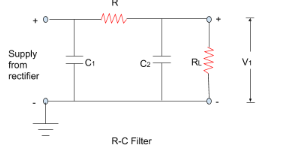
Filter circuit
A.)Eliminates a.c. component
B.)Eliminates d.c. component
C.)Does not eliminate a.c. component
D.)None of these
Answer
583.5k+ views
Hint: Electronic filters are a type of electronic signal processing system that helps in getting the pulsating DC i.e Partial AC and Partial DC.
Complete answer:
Such modules can be sold in separate products as part of an integrated circuit. In the applied signal, electronic filters eliminate unacceptable frequency elements, boost those needed or both.

The filter is a tool that enables the load portion to move through and prevents the rectifier output ac part. It ensures a constant dc voltage is the output of the filter circuit.
A variety of components such as condensers, resistors and inductors may be used to build the filter circuit. The inductor is used to facilitate the propagation of ac signals only through dc parts. Capacitor is used for stopping dc and allowing ac to move.
A rectifier is also required in order to generate pure dc supply to be used on electronic circuits in various areas. The output of a rectifier is pulse nevertheless. This indicates that it contains both the ac portion and the dc component. If a pulsating dc is added to a connection, it can generate a hum. The ac element of the pulsating rectifier production is unnecessary and needs to be held out of control. A filter circuit is used to eliminate the ac portion and require dc only. A filter circuit is an instrument that eliminates the rectifier output ac portion and enables the load to enter just the DC part.
Hence, option A is the correct option.
Note: Specifications for filter circuits exist in stereo high-performance systems that involve enhancement or suppression of certain ranges of audio frequencies for greater sound quality and energy consumption. You should be acquainted with equalizers that can be calibrated to suit the listener preference and acoustic properties of the listening environment for the amplitudes of many frequency fields.
Complete answer:
Such modules can be sold in separate products as part of an integrated circuit. In the applied signal, electronic filters eliminate unacceptable frequency elements, boost those needed or both.

The filter is a tool that enables the load portion to move through and prevents the rectifier output ac part. It ensures a constant dc voltage is the output of the filter circuit.
A variety of components such as condensers, resistors and inductors may be used to build the filter circuit. The inductor is used to facilitate the propagation of ac signals only through dc parts. Capacitor is used for stopping dc and allowing ac to move.
A rectifier is also required in order to generate pure dc supply to be used on electronic circuits in various areas. The output of a rectifier is pulse nevertheless. This indicates that it contains both the ac portion and the dc component. If a pulsating dc is added to a connection, it can generate a hum. The ac element of the pulsating rectifier production is unnecessary and needs to be held out of control. A filter circuit is used to eliminate the ac portion and require dc only. A filter circuit is an instrument that eliminates the rectifier output ac portion and enables the load to enter just the DC part.
Hence, option A is the correct option.
Note: Specifications for filter circuits exist in stereo high-performance systems that involve enhancement or suppression of certain ranges of audio frequencies for greater sound quality and energy consumption. You should be acquainted with equalizers that can be calibrated to suit the listener preference and acoustic properties of the listening environment for the amplitudes of many frequency fields.
Recently Updated Pages
Master Class 12 Business Studies: Engaging Questions & Answers for Success

Master Class 12 Economics: Engaging Questions & Answers for Success

Master Class 12 English: Engaging Questions & Answers for Success

Master Class 12 Maths: Engaging Questions & Answers for Success

Master Class 12 Social Science: Engaging Questions & Answers for Success

Master Class 12 Chemistry: Engaging Questions & Answers for Success

Trending doubts
What are the major means of transport Explain each class 12 social science CBSE

Which are the Top 10 Largest Countries of the World?

Draw a labelled sketch of the human eye class 12 physics CBSE

How much time does it take to bleed after eating p class 12 biology CBSE

Explain sex determination in humans with line diag class 12 biology CBSE

Differentiate between homogeneous and heterogeneous class 12 chemistry CBSE




